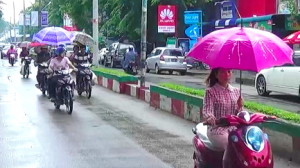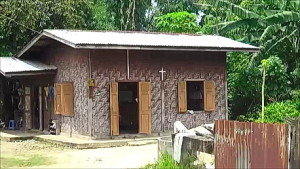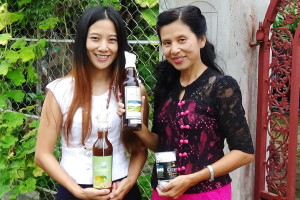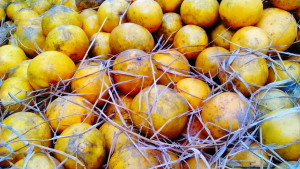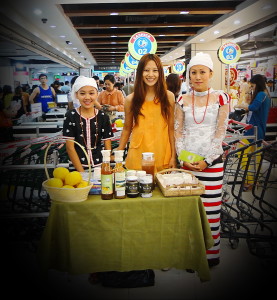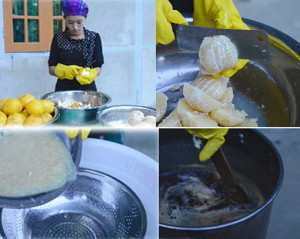I emerge from the Myitkyina airport terminal into the pouring rain and mud-sodden pathways that are the all too familiar reality of Monsoon season in Myanmar. I have come here to meet the founder of Grace Grapefruit, a small artisanal food operation that is turning citrus from the foothills of the Himalayans into juice and jam. As I stand contemplating the slippery terrain Mary San suddenly appears like a sparkling ray of sunlight with her colourful umbrella and beaming smile. “Welcome to Myitkyina. We are truly blessed that the flight was only a few hours late”, Mary says as we slip-slide our way along the muddy path to a waiting truck. “You will still be able to meet some of the ladies packing the jam.”
There is a hustle and bustle to this city that belies its remoteness. Myitkyina has been an important trading town between China and Burma since ancient times, and savvy merchants traded jade, teak, gold and khat cho rice, considered by some to be the best in the country. There are large markets and a sizable university. It is the birthplace of the Ayeyarwady River. People are on the move.
Myitkyina Township has a population of just over 300,000 but is home to an estimated 90% of the country’s Christians. As we drive towards Mary’s home I notice the numerous wooden and bamboo houses adorned with crosses prominently displayed above their entranceways. Signs announce “Faith” travel & tours and “Mercy” suppliers of what appears to be motorcycle parts, and of course Mary’s own “Grace” Grapefruit. In fact Mary informs me that it was American missionaries – in this case the Morse Family – who first brought the citrus horticulture to Kachin state in the 1930’s when they discovered the climate in Putao was similar to California. Mr. Justin Russell Morse even received a certificate of merit from the Department of Agriculture in Myanmar for his contributions to horticulture.
Mary’s family wasn’t always working with citrus. Though Mary was born in Putao (her father is from the Rawang tribe of Hta Mai village in the northernmost part of Kachin) her family moved to Myitkyina when she was very young and her father ran a photography shop there. Mary attended University in Mandalay and it wasn’t until 2004 that the family returned to her birthplace and settled into life in the north once more. It was coming home to the pristine Putao environment that precipitated her encounter with the mighty power of the humble little grapefruit.
Grapefruit is recognized and named “sick fruit” (‘Za shi’ in Rawang) by the native tribes owing to its healing properties. Indigenous people accept the grapefruit as a miracle fruit that contributes to longevity – ‘ah thet shae say’ – or ‘long life medicine’. One night whilst in prayer Mary’s mother, Daw Ei Ei Tin, experienced a vision of the grapefruit and recognized the message as a divine revelation – a calling of sorts. She spoke to Mary about it, and they decided they ought to set about fulfilling this seemingly higher purpose: healing people with grapefruit.
And Kachin needs a lot of healing. For those unaware of the history of this state, since about 1961 it has experienced an almost continuous state of conflict brought about by factious fighting between multiple parties – fuelled by a cross border trade with China in illegal jade and narcotics and natural resources. Hundreds of thousands of civilians have been displaced since the 1960’s, and have found their way (if they were fortunate) into the IDP (Internally Displaced Persons) camps within cities like Myitkyina[1]. Many of them are run by Christian churches.
People from these border regions suffer from war, poverty, isolation, unemployment, income disparity, and racial discrimination, with no guarantee of returning home anytime soon. Yet, here in the midst of it all, there are female entrepreneurs like Mary and her mother trying to reach out to the community and bring some healing and some hope along with some much needed commerce to help ensure that people can thrive.
“We support the Putao families who grow the grapefruit then we teach the women here in Myitkyina how to process the grapefruit and make grapefruit food products from the pulp, and finally we find channels to sell the products through so we can sustain ourselves”, explains Mary. They currently supply into local shops and have recently made great inroads into the Yangon market by setting up a stand in City Mart to educate shoppers on the benefits of Organic Juice and where Putao actually is.
Sure enough I make it in time to see the ladies at work with the grapefruit pulp. It has been boiled over a firewood stove for about three hours before adding cane sugar and natural honey. It forms a thick stock of gooey goodness. The packers work with a large bowl of pulp and then lovingly ladle a spoonful at a time into a small plastic paper which is wrapped by another layer of thicker paper before being sealed in a third sheet of paper (like a French bon-bon). 250 grams (about 18 little bon bons) are placed into a plastic container that sells for $1.50.
This activity is of particular interest to a closet foodie like me because I can see so much potential for it: think of gourmet pastes and jellies served with cheese; fruit and nut logs sweetened by the Putao golden honey – a heavenly taste most worthy of its’ inspired mission. But first Mary needs to get the jam into jars and the juice into bottles and deliver a fresh and hygienic product. This means teaching the ladies in her community about food hygiene and safety so she can sell value added products into higher-end expat outlets and one day maybe even export. All of this takes time, expertise and of course, money.
There is still much work to be done. Mary San would like to raise money to make a new ‘shared space’ kitchen and community training centre that could be used for product development of the existing fruit pulp bi-products (ie. Jam and other potential fruit spreads). She would then be able to invite the other food growing and producing communities from around the state in the various off-seasons to learn how to make value added products from other indigenous foods: pineapple growers, nut growers, or honey makers.
“We are proudly Kachin and want to make sure that our people are included in the modern economy now that Myanmar is opening to the world”, Mary explains. “We want people to eat healthy food and live longer and healthier lives”.
I couldn’t agree more and as I partake of some grapefruit jam I believe that it is indeed a divine product inspired by the heavens. I can’t wait for Jam 2.0!
[1] http://www.irinnews.org/report/96785/myanmar-kachin-fighting-hits-idp-health
Would you like to help Mary San?
We would like to help Mary San access grants that are available to support female entrepreneurs from remote communities in the disadvantaged areas of Myanmar. This will enable her to scale up operations and expand her sales network. This is turn supports both her community in Myitkyina with job creation and the farmers in Putao who provide her with the citrus and honey to make her products. Please contact us at myanmarnaturally@gmail.com if you would like to be involved.
